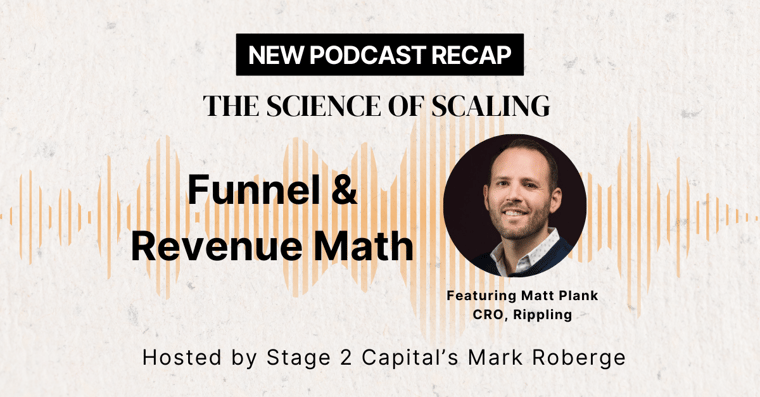Determining the right quota for a sales rep can be quite the challenge. Similarly, deciding on the quarterly budget allocation for account executives, marketing, and SDRs requires careful consideration.
In a new series from the HubSpot Podcast Network, Stage 2 Capital's Mark Roberge sits down with the most successful sales leaders in tech to learn the secrets, strategies, and tactics to scaling company growth.
Recently, he was joined by Matt Plank, Chief Revenue Officer at Rippling, to discuss how to think through all the different projections on your sales and marketing spends. Specifically, they unpack funnel and revenue math, a key piece to scientific scale, that so many boards, executive teams, and CROs miss.
You can listen to their full conversation here. Key takeaways include:
9:24 — When should you incorporate revenue math into your strategy?
During their conversation, Mark called out how Matt was "way ahead of the game, relative to peers, on revenue math, especially on the demand generation side."
According to Matt, the right time to incorporate revenue math is when you can get sales capacity to equal demand generation capacity. Mark elaborates on this idea, stating "If you have a salesperson working 40 hours a week, you should have an idea of what they can produce on a weekly basis. But, you also have to consider the demand that you're going to feed them." He adds, "Right now, that demand represents [X] opportunities per month, and the rep is turning it into [Y] deals. If you add a second rep, the two of them will likely get more than [Y] deals from the [X] opportunities — but is it going to be large enough to make the math work? You can't increase the sales capacity side, unless there's sufficient demand gen capacity."
13:31 — How do you know what good revenue math looks like?
According to Matt, the most important questions to ask are "what does it cost to hire a rep?" and "what does their quota need to be?". He says, "My rule of thumb is you want to get a 5x quota on someone's OTE. If somebody is making $200K OTE, they should have a $500K quota."
Mark suggests also considering other factors. "What if you have one rep that's creating their own demand, and another rep that has a huge marketing team feeding them leads or SDRs setting appointments? The unit economics are going to be much better for the rep fulfilling their own demand," he shares.
Therefore, you should be adding up all of this spend — on marketing, SDRs, Account Executives, etc. — when determining the cost for a sale. "Then you can do the same math to figure out what is the revenue and lifetime value from the sale, and attach it back to payback periods, or LTV:CAC. The bottom line is to have projections on spend and output to make sure assumptions going into that math spit out strong unit economics," Mark says.
22:15 — You've got your revenue machine dialed in. How does this play out 2-3 years later?
To answer this question, Matt suggests revisiting the top of the funnel. "In the earliest days of your company, you're not constrained by your TAM — there are an infinite amount of businesses to sell to," Matt says. "In order for you to hit your growing demand gen goals, you need to understand your current constraints."
"A key moment for any growing business is cracking the nut on one demand gen channel. But at some point, you saturate, and you need to add in new ones," Mark adds. He suggests testing alternative demand gen channels (cold calling, selling through partners, ABM, etc.), "a year before you need them." Why? "When you come into your annual planning process, and you need to grow by $X million, you have the math on your experiments to understand what will get you to your revenue goals."

